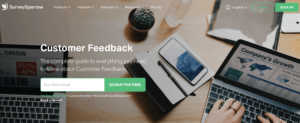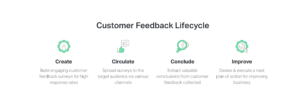VoC
Here's How To Design A Customer Feedback Loop That Works
Article written by Kate Williams
Product Marketing Manager at SurveySparrow
13 min read
19 September 2025

If you wish to build a successful product that’s scalable, talk to your customers! It’s the most direct way of figuring out if your concept of a ‘great’ product fits well with those who’ll actually use it.
Your team can validate something new before building it by conducting market research and talking to customers. But you can’t always end up badgering customers whenever you have to build something awesome.
What’s needed is a customer feedback loop to anticipate their problems and needs and start or adapt from there. Here, we talk about designing this loop in complete detail.
Let’s get to it.
What Is A Customer Feedback Loop?
Before understanding the customer feedback loop, let’s first see what a ‘loop’ means.
A loop is a process that ensures a specific action in the end. Just like feeling hungry and full is a loop created by two hormones working in sync to ensure you eat and stop doing that after a while.
The customer feedback loop is a process to ensure constant product or service development based on user sentiments and opinions. This also ensures positive customer relationships and enhanced customer satisfaction.
Why Is Customer Feedback Important?
Customer feedback is pivotal for businesses to understand and meet consumer needs. It offers insights for enhancing products and services, identifies potential issues, and fosters trust. By valuing feedback, businesses can optimize their offerings and boost overall customer satisfaction, ensuring long-term success.

Why Customer Feedback is Crucial for Businesses.
- Understanding Needs: Customer feedback provides direct insights into consumer preferences, allowing businesses to tailor their offerings more effectively.
- Enhancing Offerings: Through feedback, companies can identify areas for improvement in their products or services and make necessary adjustments.
- Spotting Issues: Negative feedback pinpoints problems in the product, service, or overall customer experience, enabling timely resolutions.
- Building Trust: Engaging with and valuing customer feedback fosters loyalty and strengthens customer-brand relationships.
- Strategic Guidance: Consistent feedback patterns can shape the direction of business strategies, ensuring alignment with market demands.
- Improving Satisfaction: Responding to and acting upon feedback can significantly boost overall customer satisfaction levels.
- Prioritization: Feedback helps businesses set priorities by highlighting areas that demand immediate attention.
- Encouraging Referrals: Satisfied customers, especially those whose feedback is acknowledged, are more likely to recommend a brand to others
The 7-Step Customer Feedback Loop Process That Works!
It’s a very well-known statistic that out of 100 customers, only 4 are willing to talk about their negative experiences with the associated brand. The rest 96, leave without complaining. And this act of leaving without explaining is what hurts a business the most.
This 7-step customer feedback loop has helped us change that at SurveySparrow. Even our clients benefit from a revamp in their feedback mechanism after we suggested these steps to them. We want the same for you, too.
Step #1: The Use, Channels, And Tools
The first step in developing a feedback loop mechanism is to identify what exactly your company will use it for. Is it going to be a product feedback loop to ensure the products in the pipeline are what the users need or will the loop be about enhancing your customer’s experience?
Why is this identification crucial? Because that will determine the target group for your feedback surveys. Then, your customer success team will determine the numerous channels for feedback collection and tools like a survey, CRM, and project management software.
Selecting the proper tools is needed because the data collected from these feedback loops have to be in a single centralized system, connected through multiple reliable tools. These tools should easily fit into the existing workflows of your Customer Success and even the Product team for faster and error-free work.
Step #2: Set A Feedback Process
Once the business goals for using a customer feedback system are decided, it’s time to define the feedback process, as in, what feedback will qualify as feedback and which target audience will be asked what?
Sign up here to elevate your customer feedback process…
14-day free trial • Cancel Anytime • No Credit Card Required • No Strings Attached
This will allow you to determine the different types of feedback questions you’re going to ask and what kind of data will go to a specific team. Simply put, you’re setting quality standards and a set format in this step for the feedback loop process to succeed.
Here’s a customer feedback template created using SurveySparrow…
Customer Feedback Survey
Use This TemplateStep #3: Establish The Analysis Method
After setting the process for feedback, it’s time to finalize how your team will analyze all the incoming data. If you’re going with a top survey software like SurveySparrow, you’ll get impressive analytics capabilities. Otherwise, investing in a feedback analytics tool makes total sense.
Choosing one centralized feedback hub for both Customer Success and Product teams will help you, as a leader, get a complete overview of the voice of the customer. Keeping both teams in the game is crucial because Customer Success often has more intimate knowledge of customer needs, and the Product team has an advantage when it comes about product capabilities.
Develop a process for feedback analysis where actual discussion or feedback from the customer is given in an accessible and open environment for both teams, either simultaneously or one after the other. These two business arms will analyze the data separately before presenting their independent findings in front of all. That’s where the next step comes in!

Step #4: Timely Communication
When you’re collecting feedback, you have to manage customer expectations. The first step is to welcome all feedback, criticism or rough ideas. But the more important step is to timely and clearly communicate to all customers that not all ideas can be implemented, either because they are too complicated and specific or because they don’t fit in a product’s landscape. And for those that can be brought to life, it requires time to execute properly, a lot of it!
With a proper communication channel, customers will know what new your team is working on, how their feedback is used during product development, and when they can expect it to come out for testing. This clarity goes a long way in satisfying customers and improves your brand’s chances of getting valuable feedback whenever required.
Step #5: Incorporating Feedback Into The Product
Until now, you have a set feedback and analysis process; you have feedback from customers and a clear communication channel to constantly stay in touch. Now, it’s time to get to work! The Product team has a clear vision for their new offering, but now… they know what the customers want from them next.
So, developing something that’s a great market fit becomes easier. However, it’s always best to invite customers for beta testing and suggestions. Why? To ensure the new product or improvements in an existing one are delivered to full user satisfaction.
Step #6: A Channel For Product Updates
Like you set channels for feedback collection at the start of the customer feedback loop, you’ll set a channel for informing customers and target audience about the new offering or improvements. This penultimate step closes the feedback loop by informing what’s new or changed based on the information gathered.
People are filled with joy and exuberance to see their ideas come to life, and if you can mention or credit the feedback that sparked the new product or update, the customer satisfaction level will skyrocket. Try it, you’ll see.
Step #7: Customer Satisfaction Surveys
The last step of the customer feedback system is to measure your customer’s love for the new, quantitatively and qualitatively.For qualitative measurement, Customer satisfaction surveys are what you need here.
Send a customer satisfaction survey after the release of the intended product or update, specifically to those customers who were involved throughout the business development process. Also, catch up with your customer advisory board and gauge their satisfaction levels about the newly released stuff. And measure the impact of the product quantitatively by looking at how well it is adopted and used.
Then, repeat the first step to continue the loop, and voila… you have a thriving customer feedback loop in your hand!

The Benefits Of Having A Successful Customer Feedback Loop
A customer feedback loop will keep customers satisfied with your brand. That much is pretty straightforward. But are there other benefits of using this system, too? Absolutely!
Here’s what we’re talking about;
Reality Check!
Even if you’ve already planned to build a particular feature, it’s time to collect feedback about it. Why? Ensure your team is building exactly what your customers need before rolling it out.
Your feedback loop should not be set in stone. A certain level of flexibility is required, and having something planned does not mean you should stop caring about its relevance. It’s even quite the opposite. Requirements and expectations can evolve quickly, and something relevant and planned for last year might have lost its value since.
Less Customer Churn
SaaS companies average at least nine competitors in a world with less product differentiation. CAC has increased by 50% in recent years, so acquiring a new customer requires a lot of resources and time.
At some point, it doesn’t matter how many new customers you onboard every month if you’re suffering from leaky bucket syndrome and losing twice as many. Death by a thousand cuts lies ahead if you stop paying attention to what your existing customers are asking for and who’s requesting it. A customer feedback system does that for your business.

Upsell & Cross-sell
Suppose you have several products or offer various product plans. In that case, the customer feedback loop allows you to sell more to your existing customers after you’ve “already paid” for the acquisition cost. Every time you add a valuable feature to a higher subscription plan, you entice clients who requested it to upgrade. That’s more money for you and more satisfaction for them!
Better User Engagement
If you never heard back from anyone the first time you gave feedback, how would you feel about giving feedback again? Not good, right? You might never give any feedback ever again and switch to another solution before anyone can do anything about it.
Now, contrast that with how you would feel if you knew exactly how and when your feedback was processed, along with its status. You’d feel more satisfied and more engaged. Well, people know you care when you give them news and the opportunity to play their role in it. It’s true in life and in business.
Growing Brand Authority
What happens when your customers engage well and are satisfied associating with your brand? They go and tell their friends, family, and colleagues about it. And just like that, your company’s reputation steadily grows, attracting more customers who are willing to pay more and stay for long.
An NPS survey will show this growing brand authority quite clearly.
Read: 10 NPS best practices to follow in 2022
Improved operational efficiency
A well-orchestrated feedback loop allows you and your team to avoid wasting time exploring less relevant or less beneficial features and functionalities. Instead of funneling your scarce resources into building features that aren’t in much demand from your users, you can turn your product team into a factory that pumps out best-selling products with a defined feedback loop.
How to Gather Customer Feedback?
Gathering customer feedback is crucial for businesses to stay attuned to their audience’s needs and preferences. Here are some effective methods:
- Online Surveys: One of the most direct ways to collect feedback. Tools like SurveySparrow make it simple, allowing you to craft engaging, conversational surveys that yield higher response rates.
- Feedback Forms: Embed these on your website or app to allow customers to share their thoughts effortlessly.
- Social Media Monitoring: Keep an eye on comments, mentions, and direct messages on platforms like Twitter, Facebook, and Instagram for unsolicited feedback.
- Focus Groups: Organize small groups of customers to dive deep into their experiences, preferences, and recommendations.
Try SurveySparrow for Free!
14-day free trial • Cancel Anytime • No Credit Card Required • No Strings Attached
Let’s Start The Loop!
People have never liked associating with brands, focusing only on sales and profitability. This transactional relationship only works in the short term for a company.
In the wake of the COVID-19 pandemic, people are more critical of who they’re associating with for their different requirements. They’re doing background checks, reading reviews extensively, and even talking to the employees of a firm before making a buying decision.
As such, the only way sustained growth can happen for a company is by building products and services for people and associating them with the process. It’s wrong to assume that ‘people don’t reply or that people don’t have time when you’re asking for feedback. Show them the importance of their opinion, and they’ll help you all along the way.
The 7-step customer feedback loop we’ve given is going to help you do that really well. For all your survey needs, our team at SurveySparrow is here 24/7. Talk to them, and let’s start the loop that brings you and your business some roaring success!
Ciao.
14-day free trial • Cancel Anytime • No Credit Card Required • No Strings Attached

Turn feedback into growth. Try SurveySparrow’s VoC platform free today!
Kate Williams
Excels in empowering visionary companies through storytelling and strategic go-to-market planning. With extensive experience in product marketing and customer experience management, she is an accomplished author, podcast host, and mentor, sharing her expertise across diverse platforms and audiences.
Related Articles

VoC
User Feedback: Definition, Importance and How to Collect it
13 MINUTES
10 May 2024

VoC
Customer Feedback Surveys Made Simple: Expert Guide + Free Templates
21 MINUTES
5 August 2025

VoC
15 Voice of Customer Methodologies to Unleash the Power of Feedback
11 MINUTES
23 June 2023

VoC
Enough already! The truth in these 10 advices we are all tired of hearing about customer feedback system.
12 MINUTES
31 December 2018
